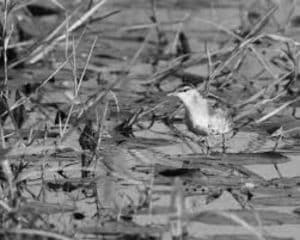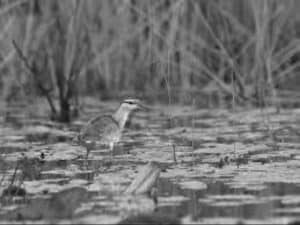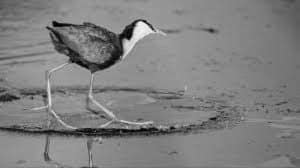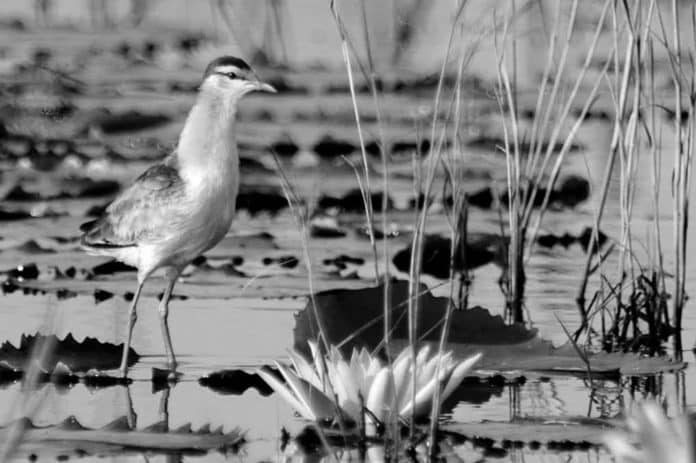Introduction to the lesser jacana
Welcome to the enchanting world of the lesser jacana in Tanzania, where delicate beauty meets wetland splendor. This captivating bird, scientifically known as Microparra capensis, is a true gem of the Tanzanian wetlands. With its vibrant plumage and unique characteristics, the lesser jacana has captured the hearts of bird enthusiasts and nature lovers alike.
Habitat and distribution of the lesser jacana in Tanzania

The lesser jacana finds its home in the lush wetlands of Tanzania. These exquisite birds can be found in various regions, including the famous Serengeti National Park, Lake Manyara, and the Selous Game Reserve. They thrive in habitats characterized by shallow freshwater marshes, swamps, and the edges of lakes and rivers.
Tanzania’s wetlands offer the perfect environment for the lesser jacana to flourish. With abundant vegetation and an abundance of insects, mollusks, and small aquatic invertebrates, these birds have an ample food supply. Their preference for densely vegetated areas allows them to navigate the water lilies and floating vegetation with ease, showcasing their exceptional adaptability.
Physical characteristics and unique features of the lesser jacana
The lesser jacana is a small bird, measuring around 7.5 to 9 inches in length and weighing approximately 1.5 to 2.5 ounces. One of its most striking features is its vibrant plumage, consisting of a combination of black, brown, and white feathers. The black head and neck contrast beautifully with the chestnut-brown body, while the white underparts add a touch of elegance.
One of the most unique features of the lesser jacana is its incredibly long toes. These toes, sometimes measuring up to four inches, enable the bird to walk on floating vegetation without sinking. This adaptation allows the jacana to access food sources that other birds cannot reach, giving it a competitive advantage in its wetland habitat.
Behavior and mating habits of the lesser jacana
The lesser jacana is a fascinating bird to observe in its natural habitat. These birds are known for their intriguing behavior, including their distinctive walking style. To move across the water lilies and floating vegetation, the jacana uses a high-stepping gait, delicately placing each foot on the vegetation to distribute its weight evenly.
During the breeding season, male lesser jacanas take on the role of caring for the eggs and young. They build small floating nests out of aquatic vegetation, carefully weaving them together to create a secure structure. Once the female lays her eggs, she leaves the male to incubate them and take care of the hatchlings. This unique behavior is rare among birds and adds to the allure of the lesser jacana.
Threats and conservation efforts for the lesser jacana in Tanzania

Despite their captivating presence, lesser jacanas face several threats in Tanzania. Habitat loss due to human activities, such as drainage of wetlands for agriculture and infrastructure development, poses a significant challenge to their survival. Pollution, including the use of pesticides in nearby farmlands, also affects the delicate balance of their wetland habitats.
To protect the lesser jacana and its habitat, conservation efforts are underway in Tanzania. Organizations are working towards raising awareness about the importance of wetlands and implementing sustainable practices to minimize human impact. Additionally, research is being conducted to better understand the lesser jacana’s ecological needs and develop effective conservation strategies.
Lesser jacana spotting tips for birdwatchers in Tanzania
For birdwatchers eager to catch a glimpse of the lesser jacana in Tanzania, here are a few helpful tips. First and foremost, wetlands are the primary habitats for these birds, so focus your search around lakes, rivers, and marshes. Look for areas with dense vegetation, as the jacanas prefer to forage and nest in such environments.
Patience is key when observing the lesser jacana, as they can be elusive at times. Take your time and scan the water’s edge, looking for any movement or flashes of color. Additionally, consider hiring a local guide who is familiar with the lesser jacana’s habitat and behavior. Their expertise can greatly enhance your chances of spotting these beautiful birds.
Lesser jacana photography tips and tricks
Photographing the lesser jacana in its natural habitat can be a rewarding experience. To capture their vibrant plumage and unique characteristics, consider these photography tips and tricks.
Firstly, choose a lens with a focal length of at least 200mm to get close-up shots without disturbing the birds. A tripod or monopod can also be useful to stabilize your camera and achieve sharp images.
When composing your shots, focus on capturing the jacana’s intricate details, such as its long toes or striking plumage. Experiment with different angles and perspectives to add variety to your photographs. Patience is key in wildlife photography, so be prepared to wait for the perfect moment to capture the essence of the lesser jacana.
Lesser jacana in Tanzanian folklore and culture
The lesser jacana holds a special place in Tanzanian folklore and culture. In some local communities, the bird is believed to bring good luck and is considered a symbol of harmony and balance. Its elegant appearance and unique behavior have inspired stories and legends that celebrate the beauty of nature and the importance of coexistence with wildlife.
The lesser jacana’s presence in Tanzanian folklore serves as a reminder of the deep connection between humans and the natural world. By appreciating and protecting these delicate creatures, we can strive for a harmonious relationship with our environment.
Lesser jacana research and scientific studies in Tanzania

Scientific research plays a crucial role in understanding and conserving the lesser jacana in Tanzania. Researchers have been studying various aspects of their behavior, habitat requirements, and population dynamics to develop effective conservation strategies.
By tracking the movements of individual birds and monitoring their breeding success, scientists have gained valuable insights into the lesser jacana’s life cycle and migration patterns. This knowledge is essential for developing targeted conservation initiatives that address the specific needs of these birds.
Conclusion: Celebrating the beauty and importance of the lesser jacana in Tanzania
The lesser jacana in Tanzania is a true testament to the delicate beauty found in wetland ecosystems. From its vibrant plumage to its unique walking style, this bird captivates the hearts of all who encounter it. However, the lesser jacana also faces numerous threats, making its conservation a matter of utmost importance.
By celebrating the beauty and importance of the lesser jacana, we can raise awareness and inspire action to protect its habitat and ensure its survival for future generations. Let us embrace the delicate splendor of the lesser jacana and work together to safeguard its place in the wetlands of Tanzania.

































